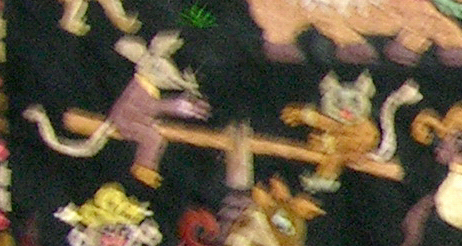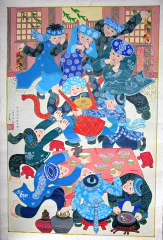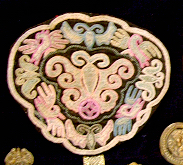 "The cat and Rat" is a Miao
legend. Photo is taken from Miao minority festival banner textile.
The following story is translated by Jessy
"The cat and Rat" is a Miao
legend. Photo is taken from Miao minority festival banner textile.
The following story is translated by JessyMyths, legends and symbols depicted on ethnic minority textiles and artifacts
The Chinese ethnic minority groups often use textiles to express the customs and "stories" of their culture. Typically, each group tells and retells the myths of the past and the hopes for the future by using various embroidery techniques on almost every textile they make. Of course, the more important the textile, the more symbols and legends are depicted. Those textiles used for babies and very young children are often of primary focus to a young woman. Baby carriers, baby blankets, booties and hats seem sometimes alive with the mothers concern for the health and good fortune of her offspring. Costumes for festivals are also heavily adorned with embroidered symbols of ancestors, heroes and evil spirits. Although Tribal Arts collectors are aware that the pictures tell a story, many do not know the actual significance of the figures depicted on their prized textile. Hopefully, this page will be a start to filling in some of those gaps.
 "The cat and Rat" is a Miao
legend. Photo is taken from Miao minority festival banner textile.
The following story is translated by Jessy
"The cat and Rat" is a Miao
legend. Photo is taken from Miao minority festival banner textile.
The following story is translated by Jessy
Originally,
rat and cat were very good friends, and rat was same sized as cat. But rat was a
little bit smarter. One day, they played along the river, and rat wanted
some fish, he asked cat to dive into the river to catch. Cat did so, but could
not came out of the water. Rat did not save the cat,
but run away.

Pumpkin Baby Miao Ethnic Minority legend
Original painting by Miao ethnic minority artist Liao Ru Jun
When a Miao couple wants to have a child but remains childless, they must go at night and steal a pumpkin. Then they invite all the friends and relatives to celebrate and welcome the (baby) pumpkin into the family. This shows the spirits how much they will love and care for a baby.
The symbols of village life are
embroidered on a Miao baby carrier.
Men carry wood, woman carry water: The sex of a baby is referred to as "someone to carry wood or someone to carry water"
Spiders are considered as possible reincarnations of past relatives, returned to keep watch over the family. The webs are left undisturbed.
Holding
hands is common border on Miao baby carriers and baby blankets. It depicts the
Miao following the ancestors commandment for the group to stay together and help each
other.
The Miao legend of the frog
queen is symbolized as a frog with a human woman's face in many older Miao
textiles. Jessy and I were told this story several years ago
and as best as we can remember...
Many years ago a frog wandered into a Miao village and decided to stay. Everyone knew that the frog was living there. The Miao love all things connected to nature. They did not want to make the frog leave. A woman in the village had a baby. One day while most of the villagers were off in the fields, an evil spirit came into the village to steal the baby. The frog saw the evil spirit and ran to warn the villagers of the danger. The villagers came running back to the village, making a great noise and chased the evil spirit away. Everyone was very happy and grateful to the frog. But the evil spirit did not go far away. It stayed out of sight and waited for another chance. Then it stole the baby. The frog ran into the forest, stopped the evil spirit and brought the baby back to the village. The frog was a hero. The ancestors were very grateful. Slowly, the frogs face began to change. Much later, the frog had the face of a woman.
 Butterfly myth
and explaination by Jessy.
Butterfly
Mother, as one of the earliest ancestors, she was born from the center of maple
tree,
she flew over and over the water, finally fell in love with the
bubble. She laid 12 eggs, bird helped to hatch the eggs, most of the
eggs were animals like water dragon, etc., the last egg was Miao people.
Butterfly myth
and explaination by Jessy.
Butterfly
Mother, as one of the earliest ancestors, she was born from the center of maple
tree,
she flew over and over the water, finally fell in love with the
bubble. She laid 12 eggs, bird helped to hatch the eggs, most of the
eggs were animals like water dragon, etc., the last egg was Miao people.
It shows the
importance of the butterfly to Miao.
Yes, Butterfly Mother has been protecting not only their kids, but also the
whole Miao group. Butterfly Mother created not only Miao, but also the
animals, because she hoped Miao would not feel alone, she believes the animals
would accompany with as well as help Miao.
Notes from Susan: The Miao refer to the bird and butterfly as Mother and Father and elements of the Miao creation myth are depicted in their textiles. Using surface embroidery techniques, they often picture birds and butterflies. The creation bubble is represented by round silver ornaments.
Coming soon....
depiction of terrace landscape